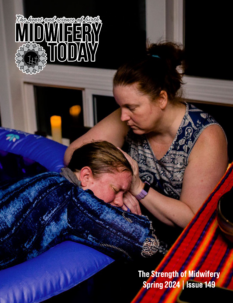
Healing Through Homebirth
Editor’s note: This article first appeared in Midwifery Today, Issue 50, Summer 1999.
Subscribe to Midwifery Today Magazine
I met Jill in January. She knew she was pregnant, but not how far along she was. She had experienced a recent episode of bleeding that lasted for weeks. Without giving her a diagnosis of what was causing her bleeding, the physician had treated her with birth control pills and pain medication.
During our first meeting, she related her history stoically and calmly. She expressed little emotion while telling of her experience of pregnancy, induced labor and the cascade of interventions that ultimately ended in the loss of her firstborn. The cause, she had been told, was that her 8 lb 12 oz baby had a “thin cord” that could not supply the oxygen he needed to withstand the stresses of labor. Her next pregnancy had been a scheduled cesarean. She had not wanted to risk making another “thin cord” or endanger her child’s life by having even one contraction. This pregnancy resulted in a healthy baby boy.
Now, pregnant again, she had recalled a bumper sticker she had seen on my car before she became pregnant, retrieving the name of my service from memory. She wondered if her history would make her too high risk for a home delivery. Upon examination of her records, I determined that she was a perfect candidate for homebirth.
We held long conversations about her lost child, talking about the labor with all its interventions, the results of each intervention and how one by one they led to another and another and another. She had entered the hospital at just a little over 40 weeks, feeling uncomfortable and crampy, having had a few sleepless nights. She was 80 percent effaced and two cm dilated and was having slight contractions. Amniotomy was performed but accomplished nothing. Pitocin was administered and seemed to be working, but the baby didn’t seem to like the contractions. Jill changed positions, which helped. Her cervix wasn’t dilating much, so more Pitocin was administered. The contractions became much stronger. The baby’s heartbeat kept dropping. The Pitocin drip was turned down and the baby improved. But Jill was becoming more anxious. The only way she felt comfortable was on her hands and knees. The contractions kept coming. The cervix had dilated to about 4 cm. By late evening an epidural was administered. Some of the pain was relieved, but something still didn’t feel right to Jill. Because the baby was stressing out with every contraction, someone decided he must be lying on his cord. Hospital personnel performed an amnioinfusion, putting fluid back into Jill’s uterus to try to float the cord away from the baby. This didn’t help. After many more hours of distress in the mother and baby, suddenly the baby’s heartbeat dropped to40 and didn’t return to its flat baseline. The Pitocin was withdrawn, but Jill’s uterus continued to contract without stopping. She was rushed to the operating room. Asked to move to the gurney, she couldn’t move her legs because of the epidural. She dragged herself onto the gurney and nearly fell. No one was helping her. Panic had set in for everyone—this baby was in danger. The records report that at the delivery of this perfect baby boy, there was a thin cord over his shoulder. He never made any respiratory efforts; his heartbeat was 70. Massive heroics were employed—his heartbeat recovered; he required intubation and full respiratory support. He began to convulse. Jill and her husband both observed this. Jill’s incision was repaired. Baby was medicated for the seizures and arrangements were made to transport the baby to the University Neonatal Intensive Care Unit. He spent 10 days on a respirator with no brain activity. He was removed from the machines and died in his mommy and daddy’s arms surrounded by his grandmothers and loving family. The diagnosis was severe asphyxia, followed by seizure disorder, followed by brain death. Jill remembers the reason as she was told—she made a thin cord. It was all her fault. Hospital personnel had done everything they could through medical technology.
I began seeing Jill every week during the beginning of her pregnancy. At 12 weeks I began seeing her every three weeks. At 28 weeks, Jill had an auto accident. She went to the emergency room of the local hospital. During her examination, the attending physician—a family practitioner who had been present at her first delivery—felt it necessary to write this note on the “instructions to patient form” at the bottom of her record: “Baby appears okay. No additional recommendations at this time. You need to be aware that your pregnancy is not a low-risk pregnancy and home delivery is not without significant risk!” He did not know anything about her pregnancy, neither had he seen records of it nor asked her how she had been feeling or doing.
During Jill’s 30th week of pregnancy she became very apprehensive and afraid. She was worried about the baby. Was it having seizures too? Part of her believed that the little one was just fine; part of her remembered a precious newborn seizing and fighting to hang on to life. Jill and I decided that it would be a great relief to her if she could have an ultrasound. The ultrasound detected a wonderfully healthy fetus. The “seizures” were probably the baby rooting and shuddering with the normal central nervous system development.
Jill’s pregnancy went post-dates. During one of the prenatals at just over 40 weeks she stated that she thought she should just admit herself to the hospital and have another cesarean. She was tired of being pregnant and anticipating the birth, and none of this was helped by the medical community’s loud protest to her about what she was doing. The doctor’s note on her chart was not easily put aside. Yet Jill was confident in my skills, in her own strength, and in the knowledge that by having this baby at home she would become empowered and heal from the previous trauma in her birth experiences. I told her that she would not think much of me as her midwife if I encouraged her to have a cesarean. She laughed and said I was right.
Finally at 42 weeks plus, Jill’s long-awaited labor began. I did not check her cervix. I watched her handling the contractions and assessed their strength by feeling them with my hand. They were strong and coming every three to four minutes. She ate Doritos, drank water, and had some tapioca pudding. She laughed about how different the atmosphere was at home than in the hospital. Fetoscope showed this baby to have a healthy, variable heart rate from 132 to 156.
At 5:37 p.m. her membranes ruptured—a beautiful, clear fluid. At this point her contractions became much stronger, and she became more agitated. We kept breathing with her, encouraging her and giving her love and strength. At 6:20 p.m. I checked her cervix. She was 8 cm! She had never been 8 cm before! She had a strong circle of women surrounding her—her mother, sister-in-law, best friend. and two midwives. Her husband was in the living room with their little boy. He seemed very nervous, and I felt sure that many emotions from the birth of their first child were occupying his thoughts. We kept inviting him to be with Jill and gave him updates. We were lucky he was even in the house. He had tried to leave, but my assistant caught him and asked him to stay.
At this point in her labor, Jill was so afraid she was crying during every contraction. The baby was putting a lot of pressure on her pelvic floor, and she felt ill. She moved to the bathroom and sat on the toilet. The walk there was tearful and dramatic. We ran a hot bath for her, which helped with her level of expression for a while, but soon we were back to the screaming and crying. She kept pleading with us to take her to the hospital; she couldn’t do this. All her support people agreed that unless the midwives detected a dangerous development, Jill should stay at home; they knew how much she wanted a homebirth and how long she had been talking about it and planning it. On the way from the bathroom to the bedroom Jill had a very strong contraction and dropped to her hands and knees, crying, “I can’t do this.” I put my arms around her shoulders and said into her ear that I knew she could do this, I had known it since the first day I met her. If I thought she couldn’t do it, I would have booted her out of the practice a long time ago. We were here to help her. Her baby was fine. She was fine. She could do it and was doing it. Then I asked her if she believed me. She said, “Yes!”
Pushing began about 9:40 p.m. She was pushing very hard in McRoberts position, her legs pulled far back, then semi-reclining against her mother. Her best friend rolled up a towel and tied a knot in it and gave it to Jill to pull on while she pushed. The baby was moving down. A little over an hour later the baby began to crown. I went to get the father. While he was watching he kept pacing back and forth in little circles, visibly shaken. This was the moment of truth for all of us. First came the little head along with a hand. Slowly the shoulders came, and then the little baby was born. He coughed and cried. His mommy picked him up and comforted all 8 lb 8 oz of him. Everyone cried, and the midwives praised God for his loving kindness.
Jill told me that every time she had a contraction the pain from the loss of her firstborn came flooding back to her. The contractions didn’t hurt so much; it was her heart that hurt. Now that she had had this experience, she said she could do anything. She is more confident and at peace. She is triumphant about her birth and knows that the only significant risk would have been to birth in the hospital again and not experience the healing that this homebirth gave her. She wants her story told so other women who have had similar experiences can feel the wholeness that she now feels. She wants to have another baby, “and this time,” she says, “I won’t scream.” After Alex was born we were informed that the police had come to the apartment in response to a call from a neighbor. We laughed and said she would be the first mom in our practice whose birth announcement would be printed in the police log of the local newspaper.


















